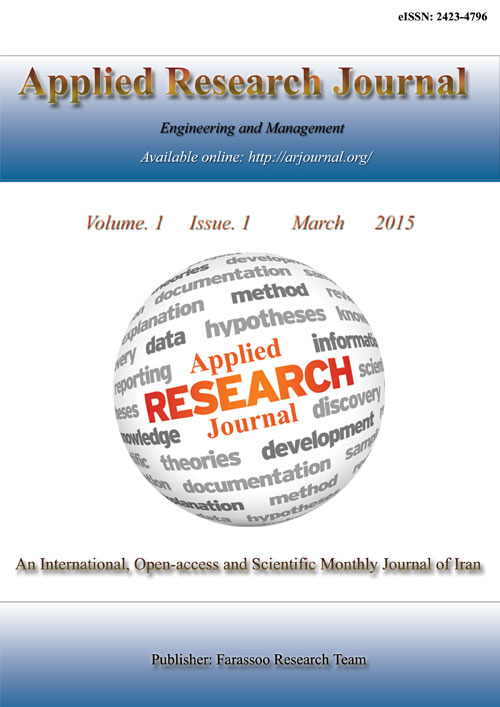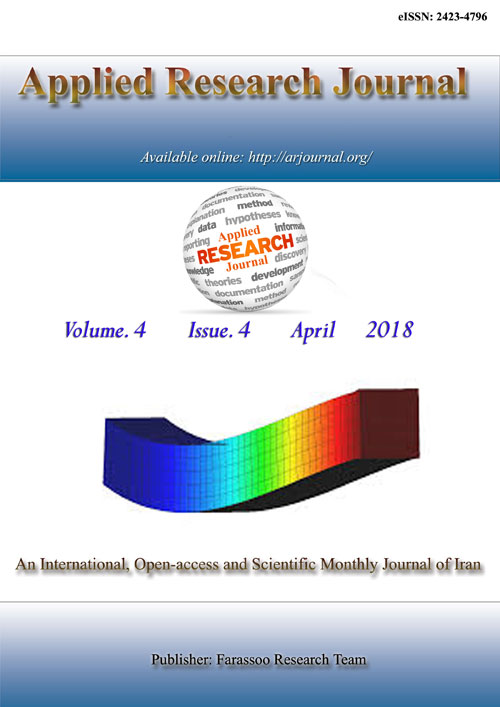فهرست مطالب

Applied Research Journal
Volume:1 Issue: 1, Mar 2015
- تاریخ انتشار: 1394/02/15
- تعداد عناوین: 4
-
Pages 1-8Castor oil is one of the most versatile plant oils. In future, with the rising environmental concerns and the need for bio-based products to replace synthetic wetting agents, castor oil and oil oleochemicals have the potential to be used in many industries. This paper carried out experimental study, through sulfation (by H2SO4) and neutralization of refined castor oil (by NaOH). The characterization analysis revealed that tested parameters, which include concentration, acid value, saponification value and iodine value for refined castor oil produced, were within the ASTM standard specifications. The iodine value obtained of the refined oil indicates that the oil could certainly be used as wetting agent and dyeing facilitator. The oil was modified via sulphation method to produce Turkey – red oil that was tested on cotton fabric dyeing. The test revealed that the TRO produced is suitable for dyeing for cotton fabric by using vat dyes.Keywords: E Castor oil, sulphation, dyeing, Turkey red oil
-
Pages 9-26Evaluating indicators such as productivity and efficiency, make managers aware at various levels of the strengths and weaknesses of the organization. In today''s business environment, organizations try to improve their efficiency in order to have more power in the global competition. The present paper presents an integrated fuzzy approach for the efficiency evaluation of industrial co-operatives. This method consists of three different techniques: (1) identify important evaluation criteria based on Balanced Scorecard (BSC) According to the previous literature review and expert preference; (2) apply fuzzy inference system (FIS) to eliminate unsuitable criterion; and, (3) develop data envelopment analysis (DEA) approach for the final evaluation. Among the indicators «The capacity of machines and production to capacity ratio» determined as the input parameters and «annual profits, customer satisfaction and continuous improvement of productivity» were considered as the output of the proposed DEA model. Finally, an actual industrial application is presented to demonstrate the proposed method. By transforming the linguistic variables to quantitative numbers by fuzzy numbers, the DEA model was formed and four units of the fifteen cooperatives were identified as efficient units..Keywords: Data envelopment analysis (DEA), Balanced Scorecard (BSC), Fuzzy inference system (FIS), Performance evaluation, Industrial co, operatives
-
Pages 27-33This research was carried out to investigate the chemical quality and fatty acids profile of Swamp buffalo milk. Material of this research was 21 buffalo milk samples, collected from Sijunjung and Batu Sangkar- West Sumatera, and Kampar-Riau, which were allocated into three groups and seven replications. Chemical quality was analyzed by methods according to SNI 01-2782-199an8 d fatty acids profile was identified by AOAC method. The results showed average of major nutrient components, namely moisture, fat, protein, lactose, mineral and solid nonfat were 79.918, 9.479, 5.470, 5.57, 0.84 and 11.70%, respectively. In the swamp buffalo milk samples, saturated fatty acids were predominant (45.2%), followed by monounsaturated (19.30%) and polyunsaturated fatty acids (1.53%).Keywords: Buffalo Milk, Milk Quality, Swamp Buffalo
-
Pages 34-40Commercial Banks are the most important contributor in the economic development of a country having a huge impact on capital and credit markets of the country. The aim of this study is to explore if commercial banks have financial difficulties. Data was gathered from commercial banks which were listed on Karachi Stock Exchange for the period 2009 to 2013. The results illustrate that all commercial banks in this model are in monetary troubles but in fact, those commercial banks are operating successfully. So, the Z score model is unable to predict bankruptcy (pecuniary Performance) of financial institutions (Commercial Banks).Keywords: Stock Exchange Pakistan, Prediction, Bankruptcy, Altman model, Financial Performance


